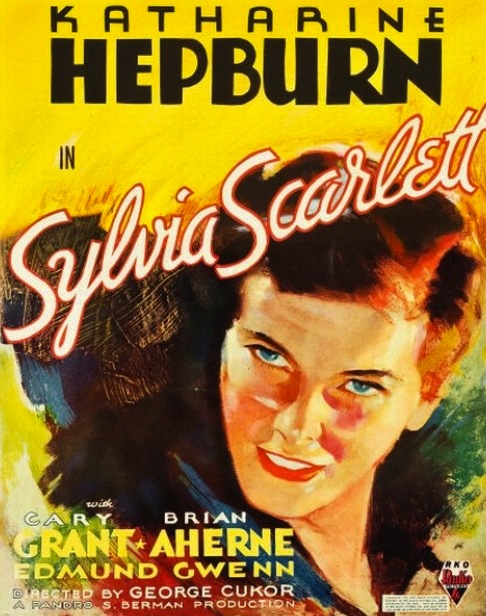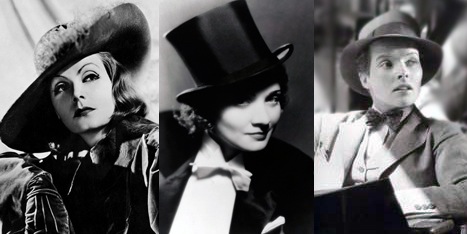A Year With Kate: Sylvia Scarlett (1936)
 Wednesday, February 26, 2014 at 5:30PM
Wednesday, February 26, 2014 at 5:30PM Episode 9 of 52 wherein Anne Marie screens all of Katharine Hepburn's films in chronological order

In which Katharine Hepburn looks better in a suit than Cary Grant.
I will never turn down a movie about a lady in a suit. Two reasons: 1) Early exposure to As You Like It and 2) An experimental phase in college film studies during which I flirted heavily with the Hays Code.
What I’m saying is, I was predisposed to love Sylvia Scarlett no matter what. Still, it wasn’t what I expected. Kate in Sylvia Scarlett gets lumped in with Greta Garbo in Queen Christina and Marlene Dietrich in Morocco as a member of the Cinematic Sapphic Sisterhood. But after this week’s viewing, I actually think that’s reductive. Instead, Morocco, Queen Christina and Sylvia Scarlett all deal with different shades of androgyny, sex, and gender.
Too academic a subject? I will include pictures of ladies kissing. I’m unselfish that way. Adjust your tie, fix your lipstick, and we'll start with Morocco.

I wrote about Marlene’s swoon-worthy swagger for Great Moments in Gayness last year, and I stand by what I said. Marlene Dietrich puts on a hell of a show in top hat and tails. Emphasis here is on the word “show."
Dietrich is the sexiest lady in spats, but she is definitely a lady. She’s curves and curls in a dashing set of menswear. That censorship-be-damned kiss is part of the act, designed to catch Gary Cooper’s attention. It’s an idea touched on in The Celluloid Closet: Dietrich’s image was based on her “exotic” sexuality. “Lesbian for show” definitely fits the bill.
 So we turn next to Queen Christina, one of only two movies where Greta Garbo does not die at the end. Queen Christina can easily be read as a guide on the Hays Code Guide On How To De-Gay. The movie starts with Garbo dressed in pants and kissing her handmaiden, but ends with her in a gown, abdicating her throne for John Gilbert.
So we turn next to Queen Christina, one of only two movies where Greta Garbo does not die at the end. Queen Christina can easily be read as a guide on the Hays Code Guide On How To De-Gay. The movie starts with Garbo dressed in pants and kissing her handmaiden, but ends with her in a gown, abdicating her throne for John Gilbert.
Since this is a Hays Code movie, Christina’s kiss is brief, not sexy. It’s more a signal that Something Is Not Right with Christina. Additionally, a major plot point relies on everyone mistaking Garbo for a man, which is only plausible because John Gilbert wears almost as much eyeliner as Garbo does. Thank John Gilbert and his curly goatee for setting her straight.
Now for Kate...

“Sylvia Scarlett reveals the interesting fact that Katharine Hepburn is better looking as a boy than a woman.”
Time Magazine was being tongue-in-cheek, but it’s not wrong. (The phrase you’re looking for is dapper as fuck.) Kate plays on her inherent androgyny as Sylvia, who passes as “Sylvester” in a convoluted plot involving con artists, suicide, and a circus. It’s clear from the start that Sylvia’s better at being masculine. Michael, her love interest - played by Brian Aherne, not Cary Grant - has to teach Sylvia how to be a girl. She’s not very good at it. By the end, Michael prefers her in pants. Still, “masculine” could read as “lesbian,” so this quick joke is designed to prove she’s straight:

Hetereosexuality affirmed! It's the second handtwitch that gets me. Anyway, Sylvia doesn’t dress as Sylvester to stir up anybody’s libido, like Dietrich. Nor is it a symptom of correctable “wrongness,” as with Garbo. Instead, the movie presents little judgement for Sylvia’s androgyny outside of a few jokes. Gender as a separate concept from sexuality or physical sex wouldn’t come about for another twenty years, so audiences had no context for Sylvia’s odd apparel. Unsurprisingly, all of this confusion led to one conclusion: the movie bombed.
Most biographers point to Sylvia Scarlett as the beginning of the end of Kate’s career at RKO. (Others list it as undeniable proof that Kate was gay/bisexual/asexual/an alien.) Kate and director George Cukor ended up renouncing the film, but the damage was done. Nonetheless, it remains the most unusual movie Kate made for the studio. Sylvia Scarlett holds a queer place in the Kate myth. Pun intended.

Previous Weeks: A Bill of Divorcement, Christopher Strong, Morning Glory, Little Women, Spitfire, The Little Minister, Break of Hearts, Alice Adams
Next Week: Mary of Scotland (1935): In which Kate dons some regal duds.



Reader Comments (3)
I had no idea Garbo had only gone two movies without croaking! I like to imagine her and Sean Bean dishing about their cinematic bad luck over margaritas.
Frivolous fantasies aside, this is a lovely piece. In an awards season where critics galore have been foot-in-mouth on the subject, it's so bracing to see the tricky subject of gender identity / sexuality / performance handled with nuance.
When I watched this the first time I so wanted to love it that when I didn't I thought I had set my expectations too high and watched it again when I had a chance with reduced hopes. I still didn't love it the second time around but didn't hate it as much as after the initial viewing. I just found it pointless, scattered and rather dull.
Kate was okay but never completely comfortable with the character. Cary Grant stole the movie right from under her nose. He's the brightest, most vital component of the whole thing. I love most of her films with Spencer Tracy and they are a great team but I have always felt that her most compatible screen partner was Grant. There is a sexiness between them that doesn't come into play with Tracy. The movie also wastes the great Edmund Gwenn in a poorly conceived part.
No wonder both Hepburn and Cukor spurned the film.
Yep, if memory serves correctly, Greta is alive when - among other movies - Grand Hotel, Queen Christina, Two-Faced Woman, Conquest and Ninotchka end. Two for sure. And Mata Hari I think ends with her walk to the execution.